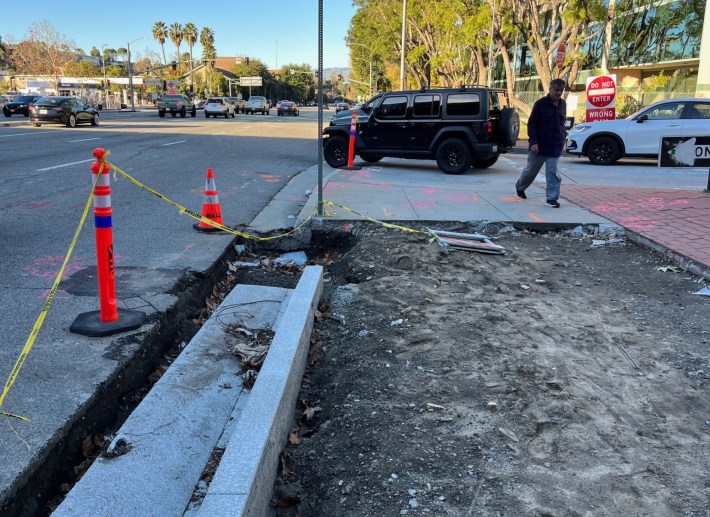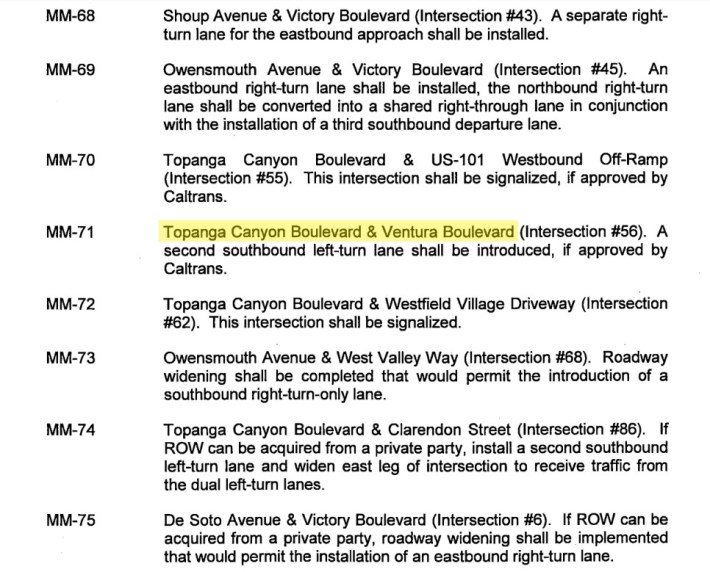Zombie engineering strikes again. Despite numerous approvals that say streets no longer need to be widened, L.A. is currently widening several blocks of Topanga Canyon Boulevard in Woodland Hills.
The city mandated widening the street in 2011, based on a 1999 street plan. That plan was overturned in 2015, but widening still got underway in 2023.
Livability advocates, city staff and elected officials worked together to shepherd plan and policy approvals that were supposed to end this type of road widening. Like a horror movie, the pernicious practice keeps returning even after it appeared to be dead.

Widening Widening All Over
Widening is expensive, and adversely impacts safety, health, climate, air, water, noise, housing, historic preservation, and more. The city's Mobility Plan says widening is "unnecessarily expensive relative to the resulting benefits" and can "change the character of the street in an undesirable way" and "result in other adverse changes."
From Wilmington to Granada Hills, from Los Feliz to LAX, the city keeps adding more lanes for drivers. When city departments aren't doing the widening themselves, they're requiring others - Metro, Caltrans, developers - to widen, even at Metro Stations, along bikeways, across bridges, and in the heart of downtown Los Angeles.

How Did L.A. Get Here?
Prior to the 2015 approval of the city's Mobility Plan, L.A. required mandatory widening of most streets, based on suburban-width street specifications approved in the city's 1999 transportation plan. If you wanted to build something new - a Metro Station, an apartment building, a store, a library, etc. - then the city pretty much forced you to widen the street.
The 2015 Mobility Plan was supposed to usher in a new multimodal era. The plan specified "new street designations that are more closely aligned with the streets’ current dimensions." The Mobility Plan trimmed quite a bit of the rampant street width excesses of its 1999 predecessor, but stopped short of ending automatic widening.
In 2019, the city approved a wonky major policy shift, measuring development impacts based on VMT (Vehicle Miles Traveled) instead of car-centric LOS (Level of Service).
This VMT policy was supposed to usher a new era where the city would prioritize TDM (Transportation Demand Management, basically strategies to reduce driving), including on "projects in the pipeline," according to the City Planning Department. In theory this meant no more city-mandated road widening. From 2019 on, new development would subsidize transit, calm traffic, and improve walkability.
What's Happening on Topanga Canyon Boulevard?
Current construction is adding more car lanes on Topanga Canyon Boulevard, at the expense of sidewalk width.
Back in 2011, the City Planning Department required a developer to widen Topanga (and lots of other streets and intersections) as a requirement for building a new mall. The Westfield company is paying their contractor who today is out widening the street.

Based on the city's 2011 requirements, widening construction is currently underway in three places:
- West side of Topanga Canyon Blvd. from the 101 Freeway to Ventura Blvd.
- East side of Topanga from the 101 to Burbank Blvd.
- East side of Topanga from Oxnard Street to Calvert Street
The street width varies somewhat, but this part of Topanga Canyon Boulevard is all at least 84 feet wide, with 7-8 lanes for cars. At Ventura Boulevard, Topanga is already 95 feet wide.
According to the 2015 Mobility Plan, Topanga Canyon Boulevard is designated as a "Boulevard II," which means it's supposed to have an 80-foot wide roadway, with two 15-foot sidewalks. According to that current city standard, new development should actually narrow Topanga from 84 feet to 80 feet.

Much of the current construction appears to be widening Topanga by around 4-5 feet, making the roadway about 88-100 feet wide. The construction is narrowing 14-15 feet wide sidewalks to ~10 feet, bringing sidewalks out of compliance with the current Boulevard II standard.
At Oxnard Street, Topanga sidewalk narrowing resulted in removal of around ten mature trees (in a part of the valley where summer temperatures soar).

(The Mobility Plan also approved bike lanes on Topanga Canyon Boulevard from Mulholland Drive to the 118. To date none of the bike lane has been installed. Measure HLA, anyone?)
One additional wrinkle is that Topanga Canyon Boulevard is officially a State Highway, SR-27. So, although the city plan specifies street standards, any changes need to be permitted by Caltrans.
According to Caltrans spokesperson Michael Comeaux, Caltrans approved permits for several phases of L.A. City/Westfield construction. In July 2023 Caltrans permitted the work on SR-27 at/near Oxnard Street. Per Comeaux, the current SR-27 construction includes LADWP water pipe and hydrant work, and "minor widening of Topanga Canyon Boulevard as well signal modifications at various intersections" and "storm drain installation and other work."
Why? Why? Why?
Why didn't the city nullify Westfield's widening requirement after approving an 80-foot street width in 2015?
Why is the city skimping on its own sidewalk width standards?
Why do city department engineers ignore council-approved street standards?
Why, in 2023, was L.A. City applying to Caltrans to widen Topanga in excess of the city's own street standard?
Why are L.A., Caltrans, Westfield, Metro still widening streets?
Why do zombies killed in 2015 and again in 2019 still roam the streets in 2024?
A Light at the End of the Tunnel
The good news is the L.A. City Council recently approved ending harmful spot road widening. This change is a two-step process, with a revised ordinance working its way through city processes. It's about six months late, but expected to come back for council approval any day now.
In theory, the new ordinance will make not-widening the default citywide.
That should be enough, right?
But, as Topanga Canyon Boulevard shows, the city council should make sure that the new no-widening ordinance is very explicit. Maybe the council could specifically cancel all stale old pending city-mandated widening based on street standards that are no longer in effect? Maybe the council could be explicit about no widening at Metro rail stations (including those currently under construction), Bus Rapid Transit facilities, affordable housing, parks, bikeways, schools, and other key locations?
The city council needs to really drive a prominent stake through the heart of this outdated harmful practice, or else it will keep rising from the grave to further endanger Angelenos.

Thanks to Twitter user @nicSTREETZ for first bringing this widening to SBLA's attention.







